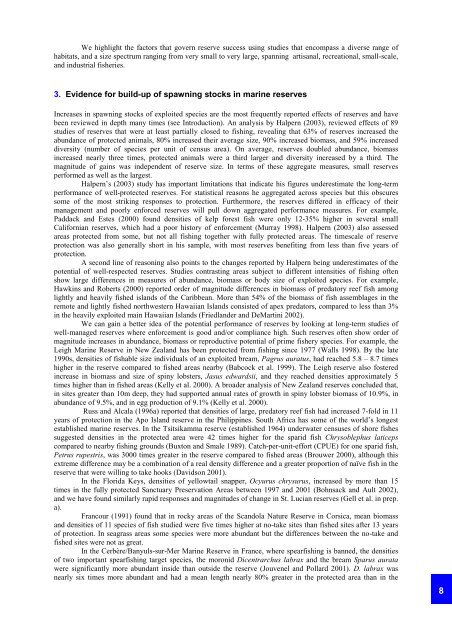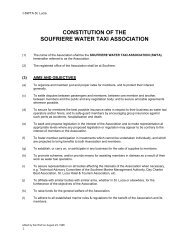WWF Cover photo - Soufriere Marine Management Association ...
WWF Cover photo - Soufriere Marine Management Association ...
WWF Cover photo - Soufriere Marine Management Association ...
Create successful ePaper yourself
Turn your PDF publications into a flip-book with our unique Google optimized e-Paper software.
We highlight the factors that govern reserve success using studies that encompass a diverse range ofhabitats, and a size spectrum ranging from very small to very large, spanning artisanal, recreational, small-scale,and industrial fisheries.3. Evidence for build-up of spawning stocks in marine reservesIncreases in spawning stocks of exploited species are the most frequently reported effects of reserves and havebeen reviewed in depth many times (see Introduction). An analysis by Halpern (2003), reviewed effects of 89studies of reserves that were at least partially closed to fishing, revealing that 63% of reserves increased theabundance of protected animals, 80% increased their average size, 90% increased biomass, and 59% increaseddiversity (number of species per unit of census area). On average, reserves doubled abundance, biomassincreased nearly three times, protected animals were a third larger and diversity increased by a third. Themagnitude of gains was independent of reserve size. In terms of these aggregate measures, small reservesperformed as well as the largest.Halpern’s (2003) study has important limitations that indicate his figures underestimate the long-termperformance of well-protected reserves. For statistical reasons he aggregated across species but this obscuressome of the most striking responses to protection. Furthermore, the reserves differed in efficacy of theirmanagement and poorly enforced reserves will pull down aggregated performance measures. For example,Paddack and Estes (2000) found densities of kelp forest fish were only 12-35% higher in several smallCalifornian reserves, which had a poor history of enforcement (Murray 1998). Halpern (2003) also assessedareas protected from some, but not all fishing together with fully protected areas. The timescale of reserveprotection was also generally short in his sample, with most reserves benefiting from less than five years ofprotection.A second line of reasoning also points to the changes reported by Halpern being underestimates of thepotential of well-respected reserves. Studies contrasting areas subject to different intensities of fishing oftenshow large differences in measures of abundance, biomass or body size of exploited species. For example,Hawkins and Roberts (2000) reported order of magnitude differences in biomass of predatory reef fish amonglightly and heavily fished islands of the Caribbean. More than 54% of the biomass of fish assemblages in theremote and lightly fished northwestern Hawaiian Islands consisted of apex predators, compared to less than 3%in the heavily exploited main Hawaiian Islands (Friedlander and DeMartini 2002).We can gain a better idea of the potential performance of reserves by looking at long-term studies ofwell-managed reserves where enforcement is good and/or compliance high. Such reserves often show order ofmagnitude increases in abundance, biomass or reproductive potential of prime fishery species. For example, theLeigh <strong>Marine</strong> Reserve in New Zealand has been protected from fishing since 1977 (Walls 1998). By the late1990s, densities of fishable size individuals of an exploited bream, Pagrus auratus, had reached 5.8 – 8.7 timeshigher in the reserve compared to fished areas nearby (Babcock et al. 1999). The Leigh reserve also fosteredincrease in biomass and size of spiny lobsters, Jasus edwardsii, and they reached densities approximately 5times higher than in fished areas (Kelly et al. 2000). A broader analysis of New Zealand reserves concluded that,in sites greater than 10m deep, they had supported annual rates of growth in spiny lobster biomass of 10.9%, inabundance of 9.5%, and in egg production of 9.1% (Kelly et al. 2000).Russ and Alcala (1996a) reported that densities of large, predatory reef fish had increased 7-fold in 11years of protection in the Apo Island reserve in the Philippines. South Africa has some of the world’s longestestablished marine reserves. In the Tsitsikamma reserve (established 1964) underwater censuses of shore fishessuggested densities in the protected area were 42 times higher for the sparid fish Chrysoblephus laticepscompared to nearby fishing grounds (Buxton and Smale 1989). Catch-per-unit-effort (CPUE) for one sparid fish,Petrus rupestris, was 3000 times greater in the reserve compared to fished areas (Brouwer 2000), although thisextreme difference may be a combination of a real density difference and a greater proportion of naïve fish in thereserve that were willing to take hooks (Davidson 2001).In the Florida Keys, densities of yellowtail snapper, Ocyurus chrysurus, increased by more than 15times in the fully protected Sanctuary Preservation Areas between 1997 and 2001 (Bohnsack and Ault 2002),and we have found similarly rapid responses and magnitudes of change in St. Lucian reserves (Gell et al. in prep.a).Francour (1991) found that in rocky areas of the Scandola Nature Reserve in Corsica, mean biomassand densities of 11 species of fish studied were five times higher at no-take sites than fished sites after 13 yearsof protection. In seagrass areas some species were more abundant but the differences between the no-take andfished sites were not as great.In the Cerbère/Banyuls-sur-Mer <strong>Marine</strong> Reserve in France, where spearfishing is banned, the densitiesof two important spearfishing target species, the moronid Dicentrarchus labrax and the bream Sparus auratawere significantly more abundant inside than outside the reserve (Jouvenel and Pollard 2001). D. labrax wasnearly six times more abundant and had a mean length nearly 80% greater in the protected area than in the8



